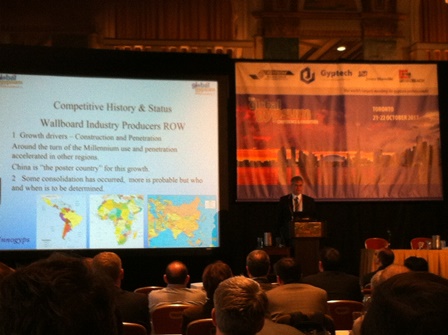Gypsum Industry Knowledge
The Gypsum Board Industry - Price and Demand
Presented at Global Gypsum Conference 2013 by Robert Morrow Introduction The Global Gypsum industry continues a journey that began a number of millennia ago. Gypsum has both inherent and adaptable characteristics that make it very attractive as an industrial mineral. It found a niche in the daily lives of countless generations throughout history. The last few decades are one of significant growth albeit with periodic interruptions. Attributes It has many positive attributes that continue to enhance our daily lives through a combination of form and function. It is abundant, low cost, easy to access by extraction from either land or water, is largely inert, easy to deconstruct and reconstruct, semi-permanent, resistant to fire and heat, solid, easy to repair and when used properly and creatively is a very aesthetically pleasing addition to our environment. Its’ uses include, plaster, drywall (wall coverings’), dental, moldings (decorative and functional), storage and serving vessels, fertilizer, soil conditioner, food additives, pharmaceutical (pills), medical, animal bedding cement additive, filler, etc. Constraints There are however some limitations to its use and disposal. It is not good for load bearing applications as it exhibits mechanical deformation under load (at Innogyps we believe there are ways to minimize or eliminate this disadvantage), it does not react well in very humid, low airflow environments; be they in structures or outdoors in stockpiles or landfills, it is heavy, albeit modern techniques for air entrainment have moderated this somewhat. The use of the product, from mine through the conversion/manufacturing process/ to installation/use and disposal is also energy intensive. Demand Drywall demand is driven by construction. In the short term the products are not price sensitive and demand is not driven by changes in price. It is important to note that the dry lining conversion process is driven by financing costs, required speed of construction (urgency of underlying demand) and labour costs. Dry lining products with a lower installed labour component are more expensive to deliver to the jobsite but are a lower cost to install where wet applied products are the reverse. Thus as labour costs rise so does the use of dry lining. While this trend is mature in North America and Japan and maturing in West and Northern Europe, it is in earlier stages around the rest of the World. Thus the issue for forecasting gypsum use is what will happen to construction demand, and to a lesser extent, the regions rate of conversion to dry linings. This document is available as a 7 page report and a 40 page slide presentation.
|
 Robert presenting at GGC2013  Price Versus Utilization |